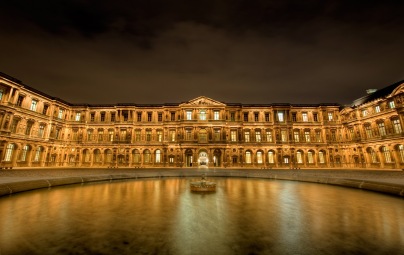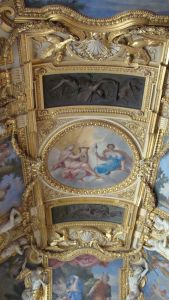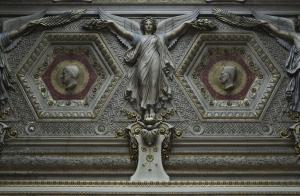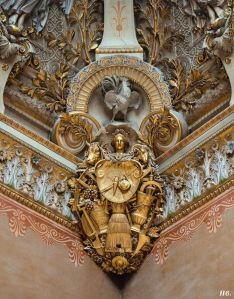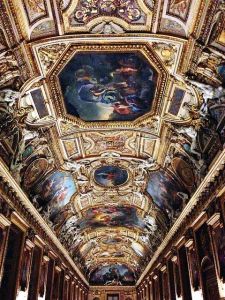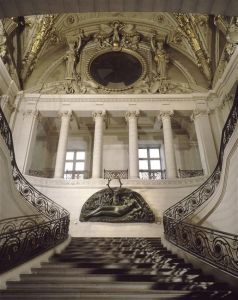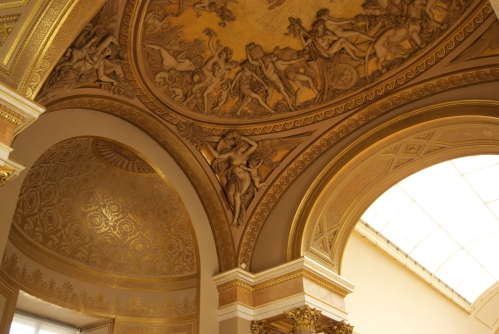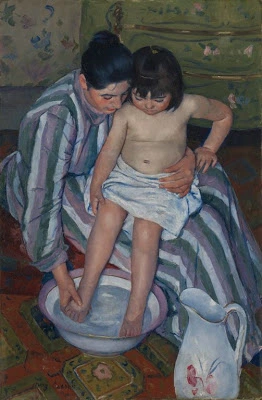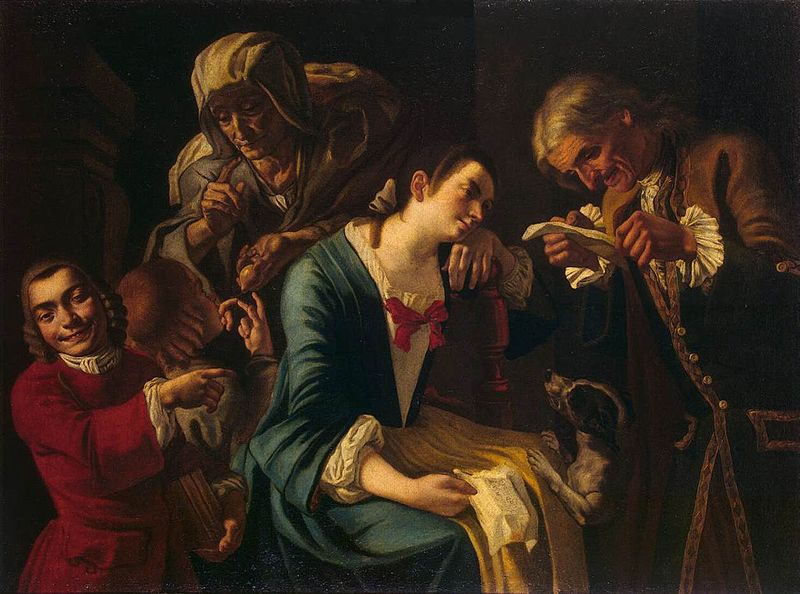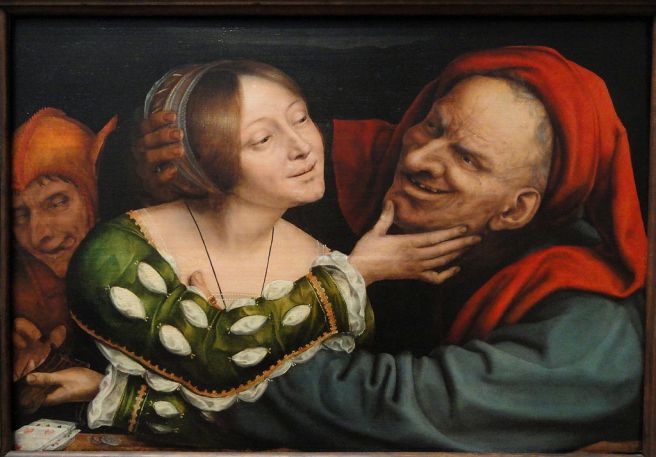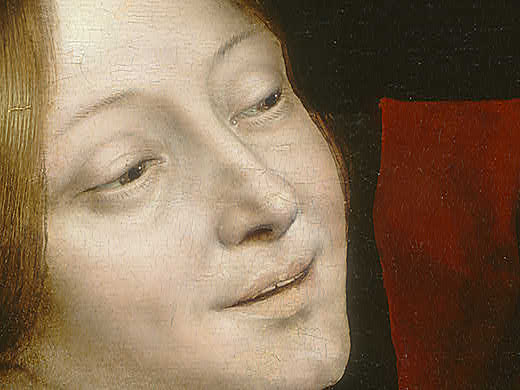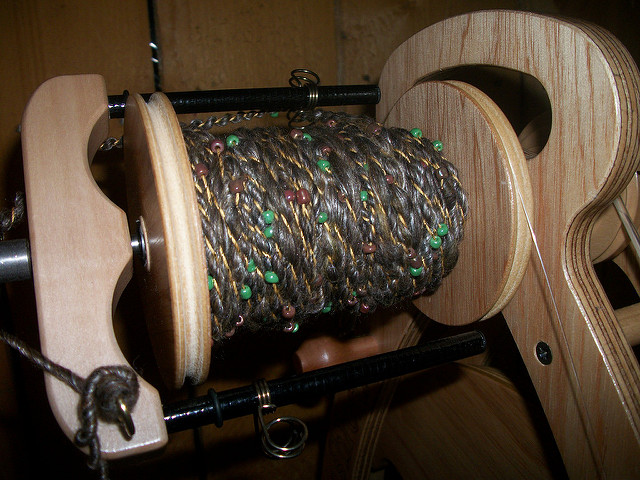
Untitled by MOGUL Stockholm, Sweden
The quote comes from Joseph Goebbels
I thought this piece made a good started for this post. I can appreciate art for arts sake, but political art has a magical aspect for me. Partly it is because of the unknown quality of the Street Artist but because it is raw. It is emotional and is meant to provoke emotion. MOGUL’s art is often confused with Banksy’s (below) as they use the same type of stencil art for their pieces. MOGUL’s art is almost always tagged (signed) where Banksy does not do this. MOGUL is unknown.
I had some trouble with this assignment at first. Six pieces, at least 2 artists of post-modern art with a theme. I thought of women in art, death… loss… I found a piece here that I liked, a piece there. Not enough and certainly not within any notion of ‘theme’ other then they were all post-modern. I went to the library and checked out actual books about post-modern art. I cleaned out the section. I marked pages. It was the last book I looked at, though, one about art installations and Street Art that got my blood pumping. I for some reason forgot how excited I get by Street Art. I think my husband is already tired of me making him look at ‘just one more.’
Street Art is a term that was popularized in the early 1980’s and although denotes a certain kind of art it is a broad term covering many different styles. A few key characteristics of Street Art are they are almost always unsanctioned art often done in / on public locations such as buildings and stairways. This form of art can be large or small, black and white or colour. It can be art for art’s sake, political in nature, satire, useable art, or anything in-between. They are rarely on canvas and can use any number of mediums. But, when is it art and when is it just graffiti?
Graffiti is most often presented in the forms of ‘tags’ which are generally a signature written or sometimes with a certain image that are meant to broadly mark that the person had been there. These can be marks of territory such as when used by gangs but also purely to mark that the person had been to this location. Tags are hard to understand to those outside of the graffiti community and almost never are intended for any other purpose then to mark the location. Street art, on the other hand, can be quick and dirty or a carefully planned piece brought to the location. It is intended to bring interaction from the public. To encourage discussion, to beautify a location, or make a statement. Street Art is meant to be ‘consumed’ by the people.

Untitled by Banksy. London, United Kingdom

Untitled dubbed “girl frisking a soldier” by Banksy picture by Pawel Ryszawa. Bethlehem, Isreal.
I thought it was interesting that Indiana University makes this distinction between Graffiti and Street Art;
“In most instances, graffitists are individuals lacking in any formal artistic training. Their goal is to “tag” or “throw up” pieces across the breadth of a city, often under time constraints imposed by the risk of fines and imprisonment.” (Indiana University – Purdue University) They include as an example of graffiti, Banksy who is the artist of the above two pieces.
They include as an example of graffiti, Banksy who is the artist of the above two pieces.
They go on to say “Street Art, on the other hand, is a more modern art form that has adopted practices from graffitists. Street artists, in many cases, are formally trained art students who pre-prepare their work before hand and arrive on location with the product.” (Indiana University – Purdue University)
I find this an interesting distinction. I think that the difference I stated earlier about graffiti mostly being a tag to demonstrate presence and largely not understood by the larger community is a definition most would agree with SI’m not sure about this idea that Street Art is purely from the realm of formally trained artists. Obviously, with some artists such as Banksy, we have no idea who they are, what training they may or may not have, or why they chose to use certain mediums. To me, Indiana’s University’s black and white distinction was a bit snooty of them. If someone isn’t formally trained then their art is automatically reduced to mere graffiti? Look at the two above images. I wasn’t able to get exact dates on the pieces but I’d venture to guess the one of the policeman frisking the girl came first. The lines are not as defined as in the second piece and it doesn’t have nearly the same level of detail. Both images though are powerful pictures, invoking strong reactions. I fail to see how one couldn’t appreciate the art in this.
In 2008 a UK newspaper ‘revealed’ Banksy as being a man named Robin Gunningham but in fact, this has never been proven. There are 5 other people who could very well be Banksy and the idea has also been floated that it may be a cooperative of artists. For someone doing this ‘graffiti’ since the early 90’s they have been a master at keeping a low profile.

Modern Youth by Kerry Roper North Ireland
To follow that up I introduce you to Kerry Roper studied graphic design and advertising at Buckinghamshire college. (Still not a ‘formal’ art student) but at least known in the artistic community haveing both done galleries as well as designing for record labels. Roper seems to have the same stencil type of design for this piece as both of the Banksy images and the MOGUL from the top. I wasn’t able to determine if this was done in/on a public space. The blue markings on it suggest it was but it may of been part of the art itself to appear more like Street Art.

The Fallen by Jamie Wardley and Andy Moss (and many volunteers) Arromanches, France. September 21st 2013

The Fallen by Jamie Wardley and Andy Moss (and many volunteers) Arromanches, France. September 21st 2013
Is it Street Art, an installation? To mark International Peace Day artists Wardley and Moss took on the task of creating 9,000 human still houses to represent the lives lost during the D-day landing during WWII. That would be the civilian, German, and Allies that lost their lives that day. A powerful image at the sheer amount of bodies on the beach. I find this piece more powerful because it couldn’t stay. It wasn’t a monument put up that people could visit and quietly forget about. It was a living breathing effort of at least a hundred people for 4+ hours of work to take a few moments to stand in awe together at what the beach once looked like in the absence of peace. It was then quitely, wave by wave, swept away. Both the stillhouses and the washing away are powerful, emotional art.
The artists created Sandinyoureye wich specialize in ice sculpture and sand art. Now also branching into animation.

Gum Election “Obama vs. McCain” , by Stefan Haverkamp & James Cooper New York City 2011
Last but not least, a bit of a lighter one to finish this off. Gum Election. A fun Street Art campaign that is continued in each political cycle. A never ending interactive art piece that encourages people to vote, voice their opinions, and to not spit out their gum on the sidewalk.
Really, my first thought was who chews gum anymore? But, apparently, that’s a me thing. This campaign has inspired others to do the same in other communities, countries, and even spoofs on this idea for product preference. I like the interactive nature of this poster. It is perhaps not as thought provoking as the others but it isn’t complete without others adding their own piece to the art.
Haverkamp teaches at the Miami Ad School in New York and came up with this idea to ask the public who sucked the most as a fun political interactive piece (and to keep the street clean.
___________
Work Cited
____
Ward, Ossian. “How Graffiti Became Art.” Time Out London. Times Magazine, 29 Jan. 2008. Web. Nov. 2016.
Berry, Francis. “DIFFERENCE BETWEEN MODERN ART AND POSTMODERN ART.” Difference between Modern Art and Postmodern Art by Francis Berry. Francis Berry, 2006-2007. Web. Oct. 2016.
“80+ Amazing Guerrilla Street Art Inspiration Examples.” Creative Guerrilla Marketing. N.p., 2016. Web. Oct. 2016.
“Street Art Exhibition Opens in Belfast.” BBC News. BBC, 08 Dec. 2011. Web. Nov. 2016.
“Aesthetica Magazine – The Street as Subject: Street Art.” Aesthetica. N.p., 09 May 2012. Web. 10 Nov. 2016.
Stefanhaverkamp. “Gum Election 2016.” Gum Election 2016. N.p., n.d. Web. Nov. 2
“Street Art by Mogul – In Stockholm, Sweden.” Street Art Utopia. N.p., 29 Mar. 2014. Web. Nov. 2016.
DeNotto, Michael. “Street Art and Graffiti.” Street Art and Graffiti. American Library Association, 2014. Web. Nov. 2016.
“Street Art vs. Graffiti.” Street Art vs. Graffiti. Indiana University, n.d. Web. Nov. 2016.
WEISBERG, Jill C. “The Difference Between Street Art and Graffiti.” The Difference Between Street Art and Graffiti | Schrift & Farbe Design Group. SCHRIFT & FARBE DESIGN GROUP, n.d. Web. Nov. 2016.
– Biography of a Graffiti Street Art Legend.” Banksy – Biography of a Graffiti Street Art Legend. Stencil Revolution, 2016. Web. Nov. 2016.
“The Fallen 9000.” The Fallen 9000. Sandinyoureye, 2013. Web. 12 Nov. 2016.
